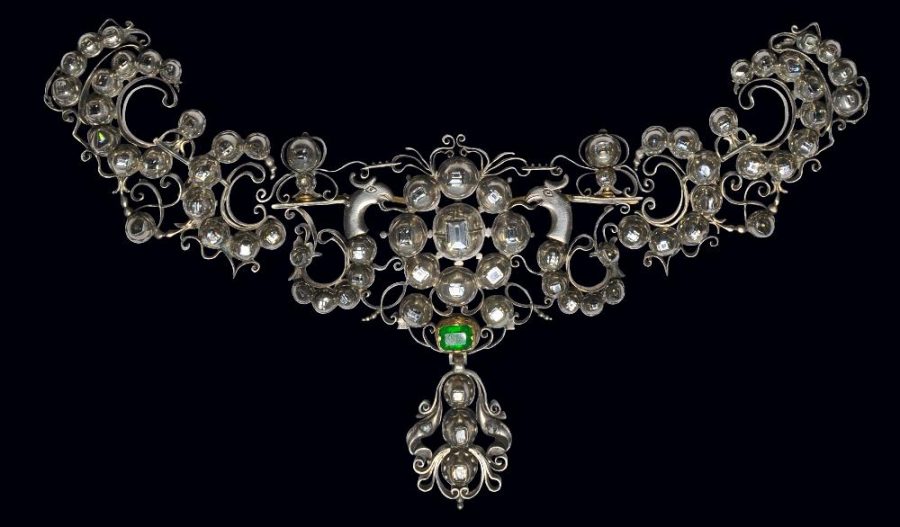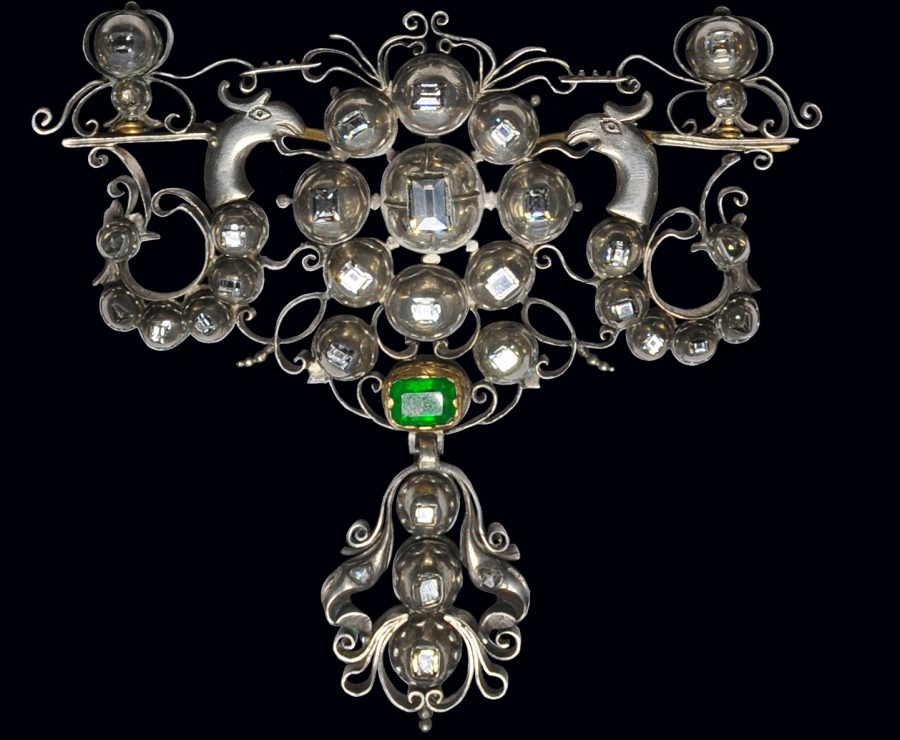This unusually large and early colonial Spanish bodice ornament in the Baroque style is from the Viceroyalty of New Spain, either Spanish colonial Guatemala or Mexico. It was designed to be sewn to the upper section of a wealthy or aristocratic woman’s bodice. It could be worn today, on a ribbon or chain, as a large, three-part pendant necklace.
It is set with 74 large, flawless, table-cut diamonds with black foiling, all mounted in silver, and a single table cut emerald doublet, mounted in gold. The ornament is in three main separate and unlinked sections. A central section is decorated with two facing bird heads around a central, diamond-set floral motif centred with a very large baguette-shaped diamond in a raised, floral box setting. A pendant drop set with three large diamonds and two smaller ones is suspended from this. Two side sections formed as curvaceous Baroque flourishes complete the set.
The backs of the main elements have been gilded and are set with small brackets to allow the ornament to be sewn to the bodice.
It is constructed almost entirely from wide, flat silver wires – an unusual type of construction largely unknown in Europe at the time. This, together with the bird-head motifs, is particularly suggestive of the ornament’s colonial Americas provenance.
Birds and bird heads that peer from behind or are surrounded by foliage is a frequent theme in colonial South American silver and leatherwork (see Rishel & Stratton-Pruitt, 2006, p. 177, for example). Bird motifs are a common feature in Baroque decoration. But birds were also among the emblems of the Viceroyalty. They were associated with Christ’s charity and sacrifice too. According to Phipps et al (2004, p. 68), Christian evangelisers equated Heaven with Eden or Paradise and the birds found there were akin to angels who could act as bearers of the voice of God. Thus birds could be equated with godliness and so were an appropriate motif to be used on personal items. Turkeys, which have a crest and are native to South and Latin America, also are frequently represented in colonial South and Latin American silverwork.
The use of flat silver wires arranged in scrolls with table cut diamonds is rare but the work is identical to that shown on a gold chalice in Guatemala’s Museo del Arzobispado (Archdiocesan Museum) and illustrated in Esteras Martin (1994, p. 285). The chalice is attributed to around 1780 but this might be too late – its decoration is more Baroque than Rococo. A dating to earlier in the 18th century seems more likely. But it is the chalice and most particularly its decoration which is key to understanding the origins of the bodice ornament.
The black foiling of diamonds was fashionable until the first few years of the eighteenth century. This suggests that the ornament dates to no later than 1720. Rishel & Stratton-Pruitt (2006, p. 81) reproduce a painting of the wealthy New Spain wife Doña María de la Luz Padilla y Gómez de Cervantes, which dates to around 1760, wearing a later bodice jewel seemingly set with dozens of diamonds, thus demonstrating that such jewels were fashionable in New Spain as well as Spain itself.
The use of silver rather than gold is also suggestive of the item’s colonial origins. Locally mined silver was in plentiful supply in 17th century South America, but gold only became more common from around 1699. Also, gold was by far the more usual material used for such an ornament in Spain itself; silver became more fashionable later. The large size of the ornament also necessitated the use of silver over gold. Quite apart from the cost, the use of gold would have rendered the piece too heavy and impractical to be worn.
Click here to see an example of a non-colonial Spanish gold bodice ornament from the same period in London’s Victoria & Albert Museum (museum no.: 325-1870). The overall form is similar to the piece here but the construction is very different. Also, the colonial South American use of bird heads is absent from the Spanish example, which is much smaller and has a clip at the back so that it can be clipped over the edge of the bodice. The example here, being large, heavier, and in three parts needed to be sewn on.
The V&A example was acquired from the Treasury of the Cathedral of the Virgin of the Pillar in Zaragoza. It was one of a group of jewels purchased by the Museum in 1870, when the Cathedral authorities sold off treasures presented to the shrine of the Virgin in order to complete their building programme. It is quite possible that the example here followed a similar route – jewels often were presented to shrines and churches and later were sold off to raise church funds.
Silver, of course, was the precious metal of colonial South America. The discovery of silver in Zacatecas in the 1540s saw the rapid development of the importance of Spain’s colonial American interests. Silver mining not only underwrote the economy of New Spain, but vastly enriched Spain itself, as well as transforming the global economy. The flow of South American silver saw a radical expansion in global trade and helped to develop an extensive trade network that connected South America with Europe, India, China and the Philippines.
The ornament is in excellent condition. It is wearable and stable. The reverse of the central pendant has been strengthened with a non-intrusive, later silver-gilt frame to protect it, further enhancing its robustness. All the original stones are present and there are no losses to the silverwork.

The reverse. The three main elements of this ornament are not joined, but they can be worn together on a chain or ribbon.
Originally, they were intended to be sewn onto a bodice.
References
Esteras Martin , C., La Plateria en el Reino de Guatemala, Siglos XVI-XIX, Fundacion Albergue Hermano Pedro, 1994.
Muller, P.E., Jewels in Spain 1500-1800, The Hispanic Society of America, 2012.
d’Orey, L., Five Centuries of Jewellery: National Museum of Ancient Art, Lisbon, Zwemmer Publishers, 1995.
Phipps, E. et al, The Colonial Andes: Tapestries and Silverwork 1530-1830, Metropolitan Museum of Art/Yale University Press, 2004.
Rishel, J. J. & S. Stratton-Pruitt, The Arts in Latin America 1492-1820, Yale University Press, 2006.







